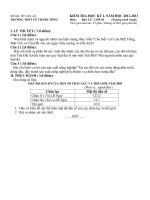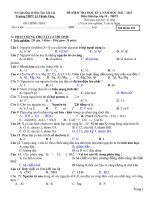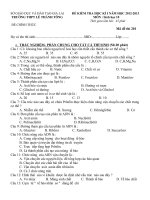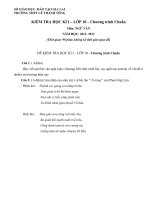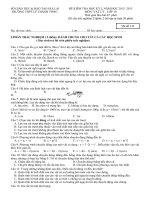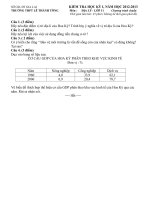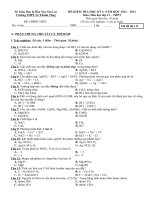AUTOMOTIVE battery , LE THANH PHUC
Bạn đang xem bản rút gọn của tài liệu. Xem và tải ngay bản đầy đủ của tài liệu tại đây (459.49 KB, 14 trang )
University of Technical Education
Ho Chi Minh City
AUTOMOTIVE BATTERIES
Le Thanh Phuc
Faculty of Automotive Engineering
Email:
1
Introduction
A lead-acid storage battery is an
electrochemical device that produces voltage
and delivers electrical current.
It's important to remember that a battery
does not store electricity, but rather it stores
a series of chemicals, and through a
chemical process electricity is produced.
2
The purpose of the battery
ENGINE IS OFF: Electricity from the
battery is used to operate lighting
accessories, or other electrical systems
ENGINE IS STARTING: Electricity from the
battery is used to operate the starter motor.
ENGINE IS RUNNING: Electricity from the
battery may be needed to supplement the
charging system.
3
Battery construction
An automobile battery contains a diluted
sulfuric acid electrolyte and positive and
negative electrodes, in the form of several
plates.
4
Cell element
Positive plates and negative plates are each
connected together by separate plate straps.
Grouping the plates in this way serves to
enlarge the surface area between the active
materials and the electrolyte.
5
Plates
Battery plates are constructed of a lead alloy
containing a percentage of either Antimony or
Calcium.
The grid provides the
necessary framework for
active material to be
pasted onto the plate.
The active material on a
charged positive plate is
Lead Dioxide (PbO2), the
active material on a
charged negative plate is
a Sponge Lead (Pb).
6
Electrolyte
Battery electrolyte is a mixture of 36% sulfuric
acid (H2SO4) and 64% distilled water (H20).
Batteries today have an electrolyte with a
specific gravity of 1.270 (at 200C) when fully
charged.
7
Specific gravity of electrolyte
Electrolyte in a charged battery is stronger and
heavier than electrolyte in a discharged battery.
The specific gravity of water is 1.000, and the
specific gravity of sulfuric acid is 1.835, which
means the acid is 1.835 times heavier than the
water.
8
Cell operation
Two dissimilar metals placed in an acid bath
produce electrical potential across the poles.
The cell produces voltage by a chemical
reaction between the plates and the electrolyte.
9
Cycling
The battery stores electricity in the form of
chemical energy.
The cycle of discharging and charging is
repeated continuously and is called “battery
Cycling”
10
Cell voltage
Each cell element of the battery produces
approximately 2.1 volts, regardless of the
quantity or size of the plates.
Automobile batteries have six cells that are
connected in series, which produces a total
voltage of 12.6 volts.
11
Battery rating
Ampere hour capacity: A battery quoted as
being 44Ah (ampere-hour) will be able, if fully
charged, to supply 2.2 A for 20 hours before
being completely discharged (cell voltage above
1.75 V).
Reserve capacity: This is quoted as a time in
minutes for which the battery will supply 25 A at
25°C to a final voltage of 1.75V per cell.
Typically, a 44 Ah battery will have a reserve
capacity of about 60 minutes.
Cold cranking amps: A typical value of 170A
means that the battery will supply this current
for one minute at a temperature of 18°C, at
12
which point the cell voltage will fall to 1.4 V
Battery charging
13
14

